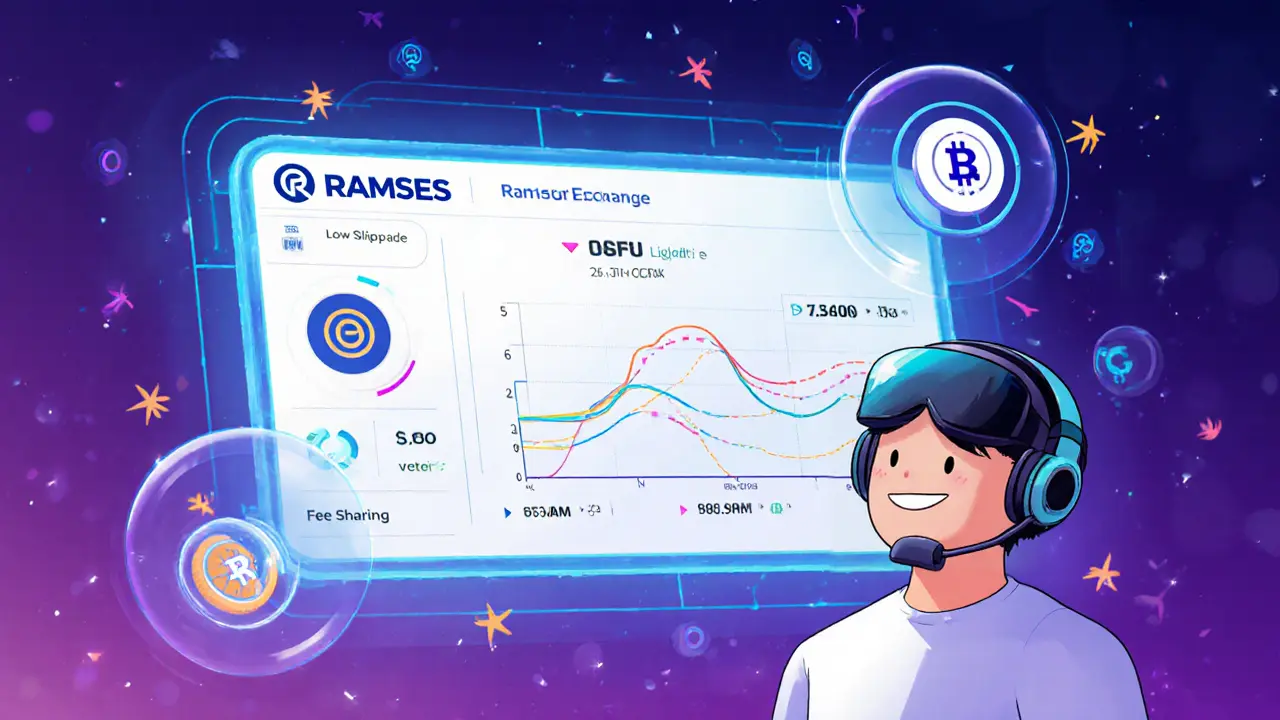
- 27 Apr 2025
- Elara Crowthorne
- 25
RAM Token Supply Tracker
Total RAM Supply
200M
Maximum supply cap
Circulating Supply
120M
Currently in circulation
Supply Distribution Breakdown
VeNFT Lock-Up Calculator
Key Insights
- Current Circulation: 60% of total supply (120 million RAM) is currently circulating
- Lock-up Incentive: Longer lock-ups increase voting power and reward eligibility
- VeNFT Benefits: Voting power, fee sharing, and access to bribe rewards
- Supply Dynamics: Remaining 40% is available for future lock-ups and emissions
Looking for an honest, no‑fluff look at the Ramses exchange review you’ve been searching for? This article breaks down how the platform works, its tokenomics, where it fits in the DeFi landscape, and what you need to watch out for before committing capital.
Key Takeaways
- Ramses combines Uniswap v3‑style concentrated liquidity with AndreCronje’s ve(3,3) tokenomics.
- The native governance token, RAM (a 200million‑supply token used for voting, fee sharing and emissions), is locked into vote‑escrowed NFTs (veNFTs) to earn rewards.
- Multi‑chain support: launched on Arbitrum (a leading Ethereum Layer‑2 scaling solution) and expanded to HyperEVM (a high‑throughput EVM‑compatible chain linked to Hyperliquid derivatives) in June2025.
- Unique “bribe” system lets projects direct token emissions toward chosen liquidity pools, jump‑starting new assets.
- Complexity is the biggest barrier - newcomers must understand AMM mechanics, concentrated liquidity, ve(3,3) incentives and veNFT management.
How Ramses Works: Core Architecture
Ramses (a decentralized exchange that blends an automated market maker with advanced token‑locking economics) operates on an AMM model similar to Uniswap v3 (the protocol that introduced concentrated liquidity ranges for LPs). Traders benefit from tighter price curves and lower slippage, while liquidity providers (LPs) can allocate capital to specific price bands rather than the whole curve.
The protocol’s incentive layer is built on the ve(3,3) model (a vote‑escrow system that aligns token holders’ interests with protocol growth). By locking RAM tokens for periods ranging from 1week to 4years, users receive a non‑fungible vote‑escrowed token (veNFT) that grants voting power, a share of swap fees, and access to “bribe” rewards.
Tokenomics Deep Dive
The RAM token has a capped supply of 200million, with roughly 60% (120million) already circulating. When you lock RAM, the protocol mints a veNFT (an NFT that represents your locked position and voting weight). The longer the lock‑up, the higher your veNFT’s voting power and fee share.
Rewards are split into three streams:
- Swap fee share: LPs earn a portion of fees from the pools they voted to support.
- Emission allocations: The protocol continuously mints RAM for distribution to voted pools.
- Bribes: Projects can deposit RAM into a pool’s bribe vault, nudging voters to channel emissions their way.
This targeted allocation model is a key differentiator from classic AMMs that spread fees evenly across all pools.

Multi‑Chain Strategy: Arbitrum & HyperEVM
Originally built for Arbitrum, Ramses quickly became the ecosystem’s de‑facto liquidity hub. In June2025 the team launched on HyperEVM, opening doors to traders seeking high‑speed execution and access to Hyperliquid’s derivatives market.
Why does this matter?
- Liquidity can flow between two fast‑growing ecosystems, increasing overall TVL.
- Arbitrum users get a familiar DEX with added cross‑chain bridges, while HyperEVM users gain exposure to the ve(3,3) incentive model.
- The dual‑chain approach mitigates risk: if one chain experiences congestion, traders can shift to the other.
Getting Started: User Journey Guide
New users typically follow these steps:
- Acquire RAM on a major exchange (e.g., Binance, Coinbase) and bridge it to Arbitrum or HyperEVM.
- Visit Ramses’s UI, select a liquidity pool (e.g., RAM/USDC), and provide capital within a chosen price range.
- Lock a portion of your RAM for a chosen duration to mint a veNFT. The UI shows expected voting power based on lock time.
- Vote for pools you want to boost. Your veNFT weight decides how much of the protocol’s emissions each pool receives.
- Monitor “bribe” opportunities. Projects often post attractive RAM rewards for votes, which can be claimed directly in the UI.
- Periodically rebalance your positions as market prices shift or as new bribes appear.
Key pitfalls to watch:
- Impermanent loss: Concentrated liquidity narrows exposure, but if the price moves out of your range, you may earn less than a traditional LP.
- Governance centralization: Large RAM holders can dominate voting, potentially steering rewards toward their own pools.
- Lock‑up rigidity: Locked RAM can’t be withdrawn until the end of the chosen period, limiting flexibility during market crashes.
Competitive Landscape: How Ramses Stacks Up
| Feature | Ramses | Velodrome | Uniswap v3 |
|---|---|---|---|
| Core AMM model | Concentrated liquidity + ve(3,3) incentives | Concentrated liquidity + ve(3,3) (simpler) | Concentrated liquidity only |
| Governance token | RAM (200M max) | VLD (no lock‑up NFTs) | None (fee‑only) |
| Vote‑escrow NFT | veNFT (custom lock periods) | ve(3,3) token lock (no NFT) | None |
| Bribe mechanism | Yes - project‑directed emissions | Limited - only via governance proposals | None |
| Multi‑chain support | Arbitrum & HyperEVM | Arbitrum only | Ethereum mainnet + select L2s |
| TVL (Oct2025) | ~$1.2B | ~$850M | ~$3.5B |
Ramses shines in its targeted fee distribution and cross‑chain reach, but it trails behind Uniswap’s sheer liquidity depth. Compared with Velodrome, Ramses offers a richer bribe system and a more granular voting power via veNFTs.

Pros & Cons Summary
- Pros:
- Near‑zero slippage thanks to concentrated liquidity.
- Tailored rewards-vote for pools you actually use.
- Strong partnership network (Liquity, Frax, Yearn, etc.) adding credibility.
- Dual‑chain deployment expands user base.
- Cons:
- Steep learning curve for ve(3,3) mechanics.
- Potential governance capture by big RAM holders.
- Locked RAM reduces capital agility.
- Impermanent loss can be higher if price moves outside set range.
Frequently Asked Questions
What is the main advantage of Ramses over Uniswap v3?
Ramses adds a governance‑driven fee routing system. By locking RAM and voting, users can steer swap fees and token emissions to specific pools, which can boost yields for the assets they care about.
How do I create a veNFT?
Deposit RAM into the Ramses UI, select a lock‑up period (1week‑4years), and confirm. The platform will mint a unique NFT that represents your locked amount and voting power.
Can I withdraw my RAM before the lock expires?
No. The ve(3,3) design requires the tokens to remain locked for the chosen duration. Early withdrawal would forfeit any voting rights and rewards.
What are “bribes” and how do they work?
Projects can deposit RAM into a pool’s bribe vault. Those RAM tokens are distributed to veNFT owners who voted for that pool, incentivizing voters to channel emissions toward the project’s liquidity.
Is Ramses safe to use?
The codebase builds on battle‑tested AMM contracts and the ve(3,3) framework, which have been audited by several firms. However, as with any DeFi protocol, smart‑contract risk remains, so only allocate funds you can afford to lose.
Next Steps for Prospective Users
If you’ve made it this far, you probably have a baseline grasp of Ramses. Here’s a quick checklist to move from curiosity to action:
- Buy RAM on a reputable exchange and bridge it to Arbitrum or HyperEVM.
- Read the official docs’ “Getting Started” section - focus on liquidity provision and veNFT creation.
- Start with a modest amount (e.g., $200‑$500) to test the UI and get a feel for voting cycles.
- Check the “bribes” tab daily; many projects post short‑term rewards that can boost APRs.
- Set reminders for lock‑up expiration to avoid accidental loss of voting power.
- Join the Ramses Discord or Telegram to stay informed about governance proposals and upcoming chain integrations.
By following these steps, you’ll reduce the learning curve and position yourself to capture the higher yields that Ramses promises.

25 Comments
If you’re eye‑balling Ramses, start by securing the basics-get RAM, bridge to Arbitrum, and lock it for a solid voting boost-this is the foundation, period! The UI guides you step‑by‑step, so no excuses; dive in, allocate modest capital, and watch fee shares trickle in. Remember, the longer you lock, the bigger the veNFT power-don’t short‑change yourself!
Reading through the Ramses review feels like stepping into a DeFi university where every lecture builds on the last, and I’m here for the full syllabus. First, the concept of concentrated liquidity borrowed from Uniswap v3 already reduces slippage dramatically, which is a win for traders who dislike price drift. Second, the ve(3,3) tokenomics layer adds a governance dimension that rewards patience, because locking RAM turns your idle holdings into active voting power. Third, the dual‑chain deployment on Arbitrum and HyperEVM widens the user base, making cross‑chain liquidity arbitrage possible without the usual bottlenecks. Fourth, the bribe mechanism resembles a marketplace for incentives, letting projects pay voters to direct emissions toward their pools, which can turbo‑charge yields on emerging assets. Fifth, the token supply distribution shows that 60 % is already circulating while the remaining 40 % is reserved for future lock‑ups, creating a built‑in scarcity schedule. Sixth, the veNFTs act as both a certificate of lock‑up and a programmable asset, meaning they can be transferred or used in other protocols that recognize the standard. Seventh, the risk profile is layered: smart‑contract risk sits at the base, governance centralization risk hovers above it due to large RAM holders, and finally the liquidity risk emerges if price moves out of your chosen range. Eighth, the user interface, while feature‑rich, can overwhelm newcomers; however, the step‑by‑step guide in the docs mitigates this steep learning curve. Ninth, the community incentives, such as weekly bribe drops and governance polls, keep engagement high and encourage a healthy feedback loop. Tenth, the audited codebase, reviewed by multiple firms, provides a degree of security, though nothing is ever 100 % safe. Eleventh, the tokenomics model aligns with long‑term holders, as longer lock periods yield exponentially higher voting weight and fee share. Twelfth, the protocol’s revenue model distributes swap fees directly to veNFT owners, creating a passive income stream that scales with market activity. Thirteenth, the integration with existing DeFi stacks, like Yearn and Frax, adds composability, allowing users to nest strategies. Fourteenth, the future roadmap hints at additional chain launches, which could further dilute risk and increase TVL. Lastly, if you’re comfortable with the complexity and willing to allocate a portion of your portfolio to locked RAM, Ramses offers a compelling blend of high‑yield opportunities and governance influence that sets it apart from standard AMMs.
Oh great, another DeFi wizardry that makes my brain melt.
Behold the labyrinth of ve(3,3) alchemy, where every locked RAM token becomes a phoenix soaring on the fumes of ambition, yet the shadows whisper that the very same fire could scorch the unwary; the colors of reward shimmer like siren lights, but the abyss of impermanent loss lurks, ready to devour those who dare to stray beyond their price bands, and so the drama unfolds in a cascade of glittering promises and hidden perils.
Here’s a quick rundown for anyone feeling lost: first, acquire RAM on a major exchange and bridge it to Arbitrum; second, head to the Ramses UI, pick a pool, and set your price range-think of it like placing a fence around the price you expect; third, lock a portion of your RAM for any period you like, the longer you lock, the bigger your voting power and fee share; finally, keep an eye on the “bribes” tab for extra RAM rewards that projects toss your way. Following these steps will get you up and running without drowning in details.
Honestly, the UI feels like it was cobbled together after a weekend hackathon-looks slick but the UX still needs polishing.
Esteemed members of this discourse, I present to you a most solemn observation: the architecture of Ramses, whilst innovative, teeters upon the precipice of complexity, demanding from its adherents a steadfast resolve and a scholarly patience seldom witnessed in quotidian ventures.
Yo, they wre just pullin a stongin curve, man… the veNFTs are like, magic, but the whole lock‑up thing smells like a con‑spiracy, ya know? Like, why “ve”?? It’s reely sus, and if the chain hiccups, ur hard‑locked cash is gone! keep ya eyes open!
The nation’s financial future depends on protecting our assets from reckless decentralization.
While Ramses introduces innovative mechanisms, the concentration of voting power among large RAM holders could undermine decentralization, a point that warrants careful monitoring.
India’s crypto scene needs tools like Ramses to dominate the global market, and any criticism is just noise from jealous rivals.
The ve(3,3) model reminds me of an elegant balance between incentive and governance; by aligning long‑term commitment with voting influence, it creates a symbiotic relationship that could foster sustainable growth.
From a systems‑design perspective, Ramses leverages concentrated liquidity-a form of liquidity binning-thus optimizing capital efficiency. Moreover, the veNFT abstraction acts as a tokenized escrow, enabling composable governance across layers. When you integrate this with cross‑chain bridges, you effectively reduce friction in capital flow, which is essential for achieving true interoperability.
Wow!!! This review really opened my eyes!!! The depth of analysis is astonishing!!! I feel both excited and terrified!!!
Ramses is the future of Indian DeFi, but if you don’t lock your RAM now you’ll miss the massive wave of wealth that’s about to crash over us.
Let’s keep the momentum going! 🌟 Remember, every lock‑up is a step toward stronger voting power and bigger rewards. You’ve got this-keep pushing those limits! 🚀
Sure, the learning curve looks steep but hey, we’re all in this together and a little confusion is just part of the adventure.
I appreciate the thorough breakdown; it helps potential users gauge the risks more clearly.
Esteemed colleagues, the philosophical underpinnings of Ramses invoke a democratic ethos, yet the practical implementation demands disciplined patience-consider this your formal invitation to partake in the governance experiment 🙂.
Oh sure, because adding more layers of voting always makes things simpler for the average user.
this platform is overhyped, not much real value lol.
Hey folks, if you’re feeling overwhelmed, start small-lock a modest amount, watch the fees roll in, and gradually increase as you get comfy. The community is always here to help you navigate the nuances.
Love the vibes! Keep the positive energy flowing, and let’s all ride the RAM wave together! 😄🚀
Yeah, because decentralizing governance is never going to lead to a few whales pulling the strings.
Our nation must champion platforms like Ramses to secure economic sovereignty and outpace the West.